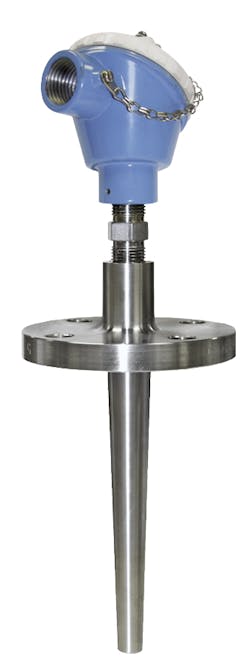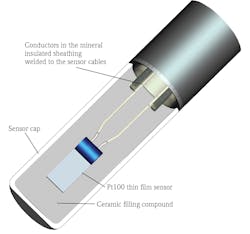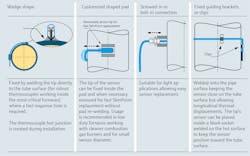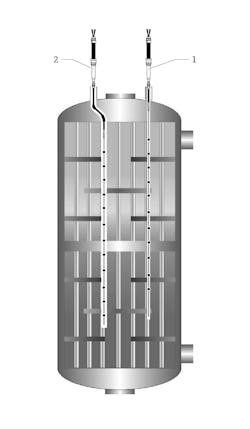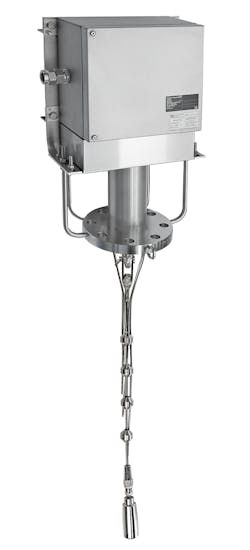Simplifying temperature measurement to deliver improved safety and increased productivity
Temperature is the most widely measured variable in most chemical plants and facilities, with readings used extensively for both monitoring and real-time control. Although temperature measurements have been made and used for decades, recent advances have made implementations simpler and safer, providing plants with opportunities for increased productivity and profitability.
This article will examine advances in each of these three areas — simplicity, safety and productivity —and show how improved temperature measurement technologies are delivering value. Temperature measurement instruments consist of a sensor and a transmitter, and this article will primarily focus on sensor advances because improvements in this area are more recent than most transmitter improvements, which have been taking place for decades.
Simplicity
One-step specification: Temperature instruments must be simple to specify, install, commission and support for full value to be realized. Specifying temperature measurement applications is complicated by the need to separately define the transmitter, sensor and thermowell. Each of these components must work together to deliver correct readings, with changes in one element often affecting another.
The thermowell must be correctly sized to house the sensor, and the sensor outputs must match the transmitter inputs. In the best case, these three separate components will be specified correctly. But in the worst case, one or more of the components will not match up perfectly to another.
Vendors have responded to this issue by offering matched thermowell/sensor/transmitter combinations (Figure 1) that can be specified using a single order code, assuring the three components coordinate properly, while simplifying the ordering process.
Whether ordered using one order code or three, the next steps are installation and commissioning.
Improved installation and commissioning: Matched thermowell/sensor/transmitter assemblies also make installation and commissioning more efficient. Because each unit is shipped and received as an assembly, technicians do not have to spend hours matching dozens, if not hundreds, of individual components. The risk of damage or loss is also significantly reduced.
Pre-configuration of the measurement span and Callendar van Dusen coefficients, if required, reduces commissioning effort and the chance of human error, such as incorrect entries and properly saving configuration values. A simple review of the accompanying documentation serves as the checklist prior to installation, assuring correct installation.
For those instances where verification of settings during commissioning is required, a matched assembly provides flexibility. Most temperature assemblies with transmitters have device type managers or device descriptions readily available. While well understood and useful, reviewing and setting these parameters requires additional software or hardware to complete the commissioning process.
Innovations such as highly secure integral Bluetooth offer another option. A technician can simply download the necessary app onto any Bluetooth-capable device (phone, tablet or laptop), stand within 40 feet of a powered instrument and perform all traditional commissioning activities — as well as view diagnostics and troubleshoot the instrument.
Superior support: Utilization of advanced diagnostics, such as those outlined in the NAMUR NE107 standard, greatly reduce downtime by simplifying and speeding troubleshooting activities. Technicians receive simple uniform NAMUR NE107 messages (Figure 2), allowing them to quickly qualify the exact nature and severity of the issue.
- Maintenance required: Low severity — existing signal is valid but remaining life is limited.
- Out of specification: Medium severity — ambient or process conditions exceeded, or the instrument is operating outside of its configuration.
- Function check: The device is in service mode (example: a technician is performing a simulation).
- Device failure: High severity — signal invalid due to a malfunction in the device.
The technician is next provided with an error code, which is a short text explanation of the specific issue at hand, along with possible corrective actions. These are provided on the transmitter’s local display or can be visualized using the Bluetooth app or other interface program.
This information allows technicians to better prioritize their activities and ensure they have the necessary components to perform a repair.
Safety
This example shows how advanced temperature instrumentation can be used to improve safety for compressor skids, with many of the benefits applicable to other types of rotating equipment.
Compressor skids are critical items of equipment for any facility. The installed cost is significant, as are any major repairs, and failure of a compressor system can place the process and personnel at risk. Monitoring of temperature on or around a compressor skid is therefore crucial for reducing risk and should be performed as follows:
- Bearings: Temperature is used to monitor bearing temperature to prevent unexpected bearing failure and possible catastrophic compressor failure.
- Inlet/outlet: These measurements can be used for process control and/or compressor protection. The compressor will have a temperature limit, and monitoring of the outlet temperature will detect unsafe levels and shut the compressor down before this limit is exceeded.
- External pressurized lubrication systems: Lubrication is circulated from a pump to the bearings in a closed loop. Temperature measurement is used to determine if the temperature of the lubricant is within the proper range to effectively protect the bearings.
Compressor skids also produce a great deal of vibration. Because standard resistance temperature detectors (RTDs) have a 3g vibration resistance, continued exposure to vibration will result in RTD drift from its original performance curve at best, or RTD failure at worst. This means most facilities face the dilemma of frequent maintenance and replacement of RTDs deployed on compressors, or put personnel, processes and property at risk by running the RTDs to failure.
Newer RTDs are available to provide a 60g vibration resistance capability (Figure 3), a 20-fold increase as compared to a standard RTD.
This provides a more reliable temperature measurement in harsh applications, thus protecting valuable equipment as well as plant personnel.
Productivity
Surface temperature measurement: Chemical plant temperature measurements are traditionally performed using a sensor, which is inserted into a thermowell for physical protection. The thermowell requires a process penetration, introducing a host of potential issues. The penetration itself requires at least a partial shutdown of the affected process or unit, and in the worst case a full plant shutdown.
Once the thermowell is installed, it becomes a maintenance concern because it is often in contact with flowing process media and is therefore susceptible to damage, and it may eventually require replacement. Other potential problems include poor material compatibility between the process and the thermowell, abrasion, excess stress on the thermowell due to wave frequency issues and leakage.
To address these and other issues, surface temperature measurement devices have been available for quite some time, but these devices have traditionally not provided the accuracy and response time required for most applications.
New technologies are addressing this issue by providing faster response times and increased accuracy, creating opportunities for use in a much wider range of applications. Because measurements are made on the surface, a variety of form factors are required to optimize the portion of the device in contact with the material. Shape options (Figure 4) include wedge, customized shaped pad, screw in/bolt on, expansion coils (typically used in conjunction with steam piping) and others.
Typical applications for surface temperature measurements include, but are not limited to, heat trace monitoring, heat transfer monitoring and measurements to implement preventative maintenance of pipe build up or corrosion.
Multipoint measurement: Many chemical plant temperature measurement applications call for multiple readings within a relatively small area of a pipe or vessel to provide temperature average detection and profiling. It is often not financially feasible or practical to make these measurements using multiple thermowell/sensor/transmitter assemblies, but solutions are available to address these issues.
Two common solutions are available for measuring temperature in storage or process vessels, such as grain and other organic bulk material storage silos, and oil and fuel storage tanks. Physical restrictions of an individual application typically determine which solution is best.
The first solution is a long, thin and highly flexible thermowell. A bendable multipoint thermocouple cable is then installed within the thermowell to provide up to 59 measurement points (Figure 5).
The multipoint measurement cable is composed of several low-diameter thermocouples protected by one overall primary tube thermowell. Due to its compact design, this solution works well with small diameter NPT vessel connections, as well as more traditional flange connections, and it can also accommodate an offset insertion path. The cable is connected to a specially designed temperature transmitter to accept multiple signals, which can be transmitted to a host control or monitoring system using either 4-20mA signals, or one digital communications link such as EtherNet/IP or Profibus PA.
The second solution is similar in concept, but in this case up to 40 thermocouple or RTD sensors are fitted externally to a metal rope. The device’s mechanical robustness and accurate temperature sensors offer the necessary characteristics for safe, reliable and economic product storage operation monitoring (Figure 6).
Custom multipoint assemblies are also available to monitor temperatures in a variety of applications.
Conclusion
Temperature measurements have been made in chemical plants and facilities for decades, but certain issues remain when using traditional technologies. Newer solutions address these issues to provide simplicity and improved safety, creating opportunities for increased productivity and profitability.
Although some applications are straightforward and can be designed readily using online tools, others are more complex and may require consultation with vendor experts, so the selected supplier should be able to provide these services upfront.
Keith Riley is the national product manager for pressure and temperature at Endress+Hauser. He has been with the company since April 2008. Prior to this, he was a product manager and regional sales manager with L.J. Star Incorporated, as well as a product manager for Penberthy (Tyco Valves). Overall, he has more than 20 years of sales, marketing and instrumentation experience in the process industries.

